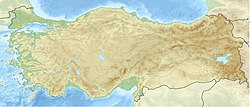Top Qs
Timeline
Chat
Perspective
1970 Gediz earthquake
7.2 magnitude earthquake in western Turkey From Wikipedia, the free encyclopedia
Remove ads
The 1970 Gediz earthquake, also known as the 1970 Kütahya-Gediz earthquake (Turkish: 1970 Gediz depremi) struck western Turkey on 28 March at about 23:02 local time with an estimated magnitude of 7.2 on the Mw scale.[3]
Remove ads
Geology
The earthquake was active on the "Turgutlu-Sındırgı-Simav-Gediz fault" line in the second-degree earthquake zone. The earthquake occurred due to the vertival movements of a fault line extending in the northwest direction from Akçaalan-Kayaköy and Dereköy to Hisarcık and the fault line extending in the direction of Çomaklar-Çukurören villages. The earthquake area was formed 2.5 million years ago. After the earthquake, a 7 cm (2.8 in) horizontal and 15–20 cm (5.9–7.9 in) vertical-slip fissure with a largest opening of 50 cm (20 in) was detected at the foot of Seyranbaşı Hill near Yunuslar Village. A 10–15 cm (3.9–5.9 in) vertical-slip fissure was observed in Çavdarhisar. Tension crack systems were detected at the junction of Gediz River and Bulacık Creek to the south of Gediz district center and around Çayçinge Village. According to the Richter scale, it was measured as 7.2 in Gediz, 7 in Emet, 6 in Simav and 5 in Kütahya.[4]
Remove ads
Damage and casualties
The earthquake killed 1,086 people, injured 1,260, while 9,473 buildings were destroyed or severely damaged leaving around 26,000 people homeless in Gediz.[1][5][4] Many people were burned alive as fires broke out from overturned stoves.[1] The earthquake caused destruction in an area of 13,250 km2 (5,120 sq mi), and was felt in 45% of Turkey.[4]
International Search and Rescue Response
In the aftermath of the earthquake, the Turkish government mobilized national resources, including the military and civil defense units, to conduct search and rescue operations. The Turkish Red Crescent (Kızılay) played a crucial role in providing emergency relief, such as tents, blankets, and medical supplies, to the affected population.[6][7]
International assistance was also extended to support the relief efforts. Various countries and organizations contributed humanitarian aid, including medical supplies, food, and financial assistance. While specific details on the deployment of international search and rescue teams are limited, the collaborative efforts between national and international entities were instrumental in addressing the immediate needs of the disaster-stricken region.[6][7]
Aftermath
Gediz, a district of Kütahya Province situated 98 km (61 mi) southeast of Kütahya, was a town that experienced repeated natural disasters including earthquakes and floods. It was relocated following a government resolution soon after the destruction to a new location that was 7 km (4.3 mi) away on the road to Uşak with the new name of Yeni Gediz (English: New Gediz). The residents moved in their newly built, earthquake-resistant homes. Neighboring towns and villages were also rebuilt at places with relative minimum earthquake risk.[1]
Other major earthquakes occurred in Gediz in 1866 and 1896, and on 25 June 1944, at 07:20 local time, a magnitude 6.0 earthquake occurred in Gediz, killing 20 people and damaging around 3,500 buildings.[1]
Remove ads
See also
References
External links
Wikiwand - on
Seamless Wikipedia browsing. On steroids.
Remove ads
